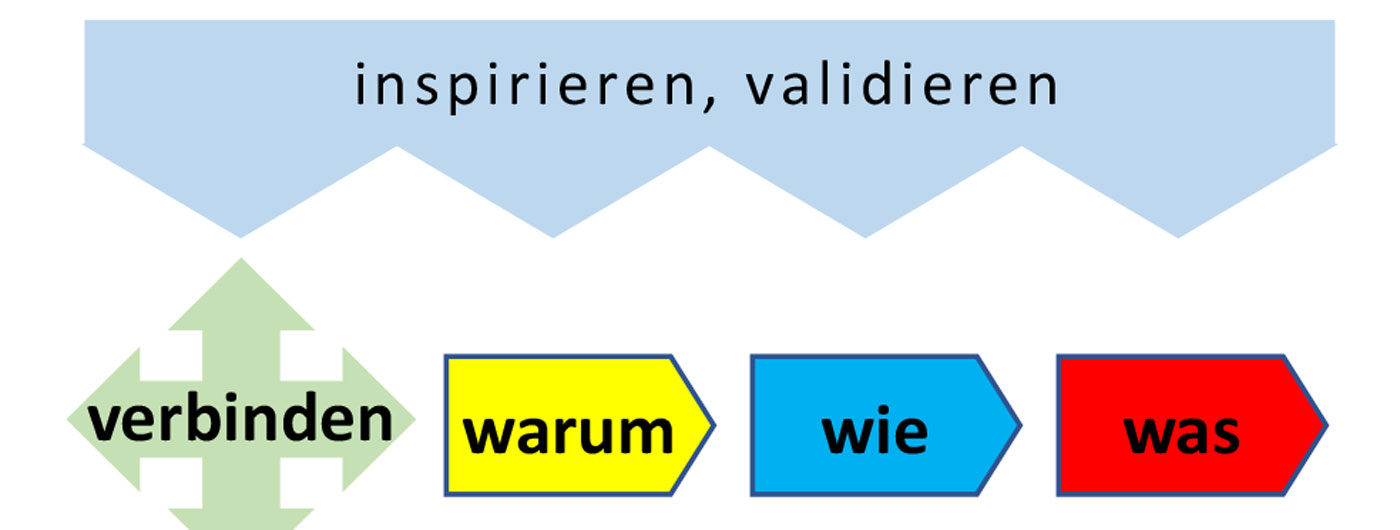A good school building supports teaching and learning. The task of developing a new school building automatically raises the question of how a school envisions its future direction. It is tempting to start with a list of things needed in the building ( WHAT). The result is a hodgepodge of desires whose coherence and necessity are not always clear.
By taking WHY as a starting point and using it to describe an inspiring, welcoming perspective, all the pieces can fall into place. Simon Sinek’s “Golden Circle” model describes this relationship between “why, how, what”.
The manual follows this idea. All workshops are structured according to the categories vision(WHY), strategy(HOW) and concretization(WHAT) and supplemented by the following two topics.
To ensure a good start of the process, a “connection” of all participants with each other and with the topic has to be established.
The goal of the process is to provide participants with inspiring perspectives and to compare their results with what others have thought about them.
Example: The 24-hour learning room
An example of why-how-what is the 24-hour project “Lern-Raum” (learning room), as it took place, for example, at the Joseph-Beuyss-Gesamtschule (Düsseldorf) and the Anne-Frank-Berufskolleg (Münster).
The 24 hours consist of alternating forms of work to match the energy of those present. Those in attendance represent the entire school, from leadership to learners.
At the 24-hour meeting, collaboration, forward thinking and creativity ensure the success of the meeting, monitored by the process facilitator . During the construction and organization, this person also provided the necessary inspiration, i.e. information from the outside in.
On you and you with the others
As a rule, the participants already know each other. So I ask them what inspires them to work in education. It’s not something you talk about very often. In doing so, I try to inspire their enthusiasm for education; because education is an important and wonderful profession. That’s why, at the beginning of a workshop, participants choose an educational quote that speaks to them or write out their own educational motto.
Method
A project learning space is a learning situation where people learn from each other. Right at the beginning we explain how the day is structured and why the method is used. This information helps motivate and engage all participants.
A recurring E-workshop element is the PrismaTable . This method is based on the ideas of Prof. Clare W. Graves and approaches each question from six perspectives. Each perspective has its own color.
The colors purple and blue convey security and structure: learning from yesterday.
Green and yellow are more oriented towards the future: Look to tomorrow.
Red and orange like to get to work quickly: act today.
With this approach, all individual strengths are combined into a true learning community where people learn from each other.
WHY phase (vision)
In the why phase, I encourage everyone to think freely. Even if you come up with crazy ideas, there can be a good thought behind them. The result consists of starting points and reference images.
With the pedagogical vision as a starting point, there are the perspectives : School climate
- Teaching quality
- Diversity
- learning organization
- Performance and
- Responsibility
Participants work in groups and compare their results with the research findings of Prof. O. Köller (The Excellent School). Then everyone works on ideas of the ideal learning space. In doing so, participants ‘they start where they want and can also respond in writing to the thoughts of others.
HOW phase (strategy)
In the How phase, the focus is on exploring how the functions can be combined in an ideal situation.
It is important to find the right balance between safety, challenge and sense of community. At the beginning of this round, we explain why Prof. S. Kagan’s ideas (Matching, Stretching, Celebrating) are a good foundation for this phase.
The goal is to find out what belongs together and why. This leads to different models or scenarios, all resulting from the assumptions of the previous rounds. Examination of models and scenarios in the how phase may also still lead to additions or adjustments to the starting points.
The discussion leads to a preferred model. This is important information for architects.
WHAT phase (concretization)
On the second day, the group continues the work. All results and models are visibly present, memories of consultations and discussions are still fresh. The concretization is a test of the starting points, if necessary they are adjusted. The process from vision to concrete result generates a lot of positive energy and anchors the principles in the memory of those present. This can be, for example, the distribution of classes in existing and new buildings, the design of meeting places and much more.
The learning room project ends with agreements on communication, data processing and follow-up.
Alternative
An alternative to a 24-hour project learning space is to break the process into three separate sessions. This has advantages and disadvantages.
Advantages
- better appointments
- Time to internalize
- possible study trip between step 2 and 3.
Disadvantages
- More energy consuming for the participants
- Lower feedback possibilities between the three phases
- longer process time
- too abstract for the first session
The success of each phase is determined by the factors of collaboration, forward thinking and creativity. And these factors are strongly influenced by the structure of the workshops, the variety of teaching methods, the energy composition and the skills of the workshop leader The manual explains this in more detail.
